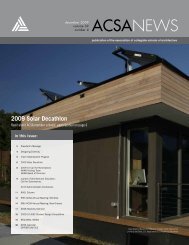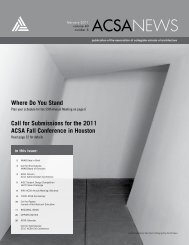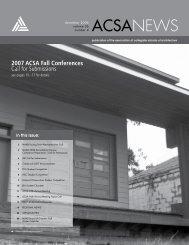digital aptitudes - Association of Collegiate Schools of Architecture
digital aptitudes - Association of Collegiate Schools of Architecture
digital aptitudes - Association of Collegiate Schools of Architecture
Create successful ePaper yourself
Turn your PDF publications into a flip-book with our unique Google optimized e-Paper software.
SATURDAY, MARCH 3, 2012 - 12:30PM - 2:00PM<br />
Technology Continued<br />
Points + Clouds: Tactical Hermeneutics:<br />
Robert Yuen, University <strong>of</strong> Michigan<br />
“We hold to the idea that architecture is not simply reducible to<br />
the container and the contained but that there exists a dynamic exchange<br />
between the life <strong>of</strong> matter and the matter <strong>of</strong> our lives.”<br />
Reiser + Umemoto<br />
Device: an instrument or tool designed for a specific task or set <strong>of</strong><br />
tasks.<br />
Abstraction: the act, idea or concept that filters or extracts, manipulates,<br />
and distorts specific elements from the whole.<br />
Tooling: the process <strong>of</strong> engaging the tool itself within the design<br />
process.<br />
Apparatus: the collection or family <strong>of</strong> instruments, devices and tools<br />
designed for a particular purpose.<br />
Atmospheric: have an emotional quality that resembles that <strong>of</strong> air,<br />
wind, and cloud.<br />
Research-through-Tooling as an explicit vehicle, provokes interrogations<br />
and explorations <strong>of</strong> environments. It consistently reiterates<br />
the condition that minds the gap, situated between spatial representation<br />
and the built environment, informed through a series <strong>of</strong><br />
hermeneutic devices. The devices create the occurrence <strong>of</strong> mistruth,<br />
errors, holes, and mistakes that formulate poetic spatial possibilities.<br />
The potency <strong>of</strong> the unfamiliar and the unseen that lurks within the<br />
atmospheric construct is exploited. It is simultaneously ambiguous<br />
and specific to the slippage between spaces and realms. Defined<br />
tactics expand the traditional thinking <strong>of</strong> spaces and volumes as dualities<br />
<strong>of</strong> surfaces and solids to a notion <strong>of</strong> points and clouds: the<br />
atmospheric.<br />
Heremeutic Series<br />
Interpretation <strong>of</strong> spaces, and designing around techniques but not<br />
reliant on them to design transmissible, navigational properties <strong>of</strong><br />
space. Conceptualizing space between the dualities <strong>of</strong> surfaces and<br />
solids to a notion <strong>of</strong> points and clouds: the atmospheric, draws on<br />
the questions <strong>of</strong> authenticity and the infidelities. Producing a body<br />
<strong>of</strong> work that explores interpretation through representation <strong>of</strong> reality<br />
that is full <strong>of</strong> errors, distortions, gaps, and residue. The drawings<br />
act as markers for the next projective moments <strong>of</strong> this work.<br />
“Space becomes a background for interaction rather than a co-producer<br />
<strong>of</strong> interaction. But what takes place is, in fact, a double movement:<br />
the user’s interaction with other people co-produces space<br />
which in turn is a co-producer <strong>of</strong> interaction. Through focusing on<br />
our agency in this critical exchange, it is possible to bring our spatial<br />
responsibility to the fore.” Eliasson, Olafur<br />
58 - ACSA 100th Annual Meeting<br />
The research project exams and unveil this condition <strong>of</strong> space<br />
through the use <strong>of</strong> <strong>digital</strong> technology to map and project alternate<br />
realties that co-exist within. It draws a spatial condition in a different<br />
light prior to traditional techniques <strong>of</strong> 2D representation <strong>of</strong><br />
solid and void within the discipline <strong>of</strong> architecture. The project is<br />
a protagonist within the movement <strong>of</strong> spatializing conditions as<br />
atmospheric representations.<br />
It is ambiguity and specific.<br />
It is relational.<br />
It is real.<br />
It is meaningless but meaningful.<br />
It operates through modes <strong>of</strong> vehicles.<br />
It crosses technological bearings.<br />
It is a paradigm shift.<br />
It is within the discourse <strong>of</strong> spatial understanding and perception.<br />
Spider Cow: Design/Build Project for a Moveable<br />
Interior Partition System<br />
Craig Griffen, Philadelphia University<br />
This project was the main component <strong>of</strong> a 3-credit Design/ Build<br />
course <strong>of</strong>fered to 4th and 5th year architecture students. A newly<br />
renovated building on our campus had flexible lobby space that<br />
was planned to be open for exhibits and events but also needed<br />
to be partially closed <strong>of</strong>f to accommodate drawing courses. So<br />
the university asked the students to design and build a partition<br />
system that would provide visual privacy, be easily moved for spatial<br />
flexibility and be durable. An additional concern was the need<br />
to reduce the reflected noise created by many hard surfaces in<br />
a shared space so an acoustic dampening role was added to the<br />
program.<br />
For the main project each student created an individual design<br />
from which similar ideas were combined to form 4 groups <strong>of</strong> 3 students.<br />
These groups designed 4 unique partition systems and the<br />
winning entry was selected by faculty and studio vote for construction.<br />
The winner was selected in part because it had the greatest<br />
chance <strong>of</strong> success but also the greatest chance <strong>of</strong> failure, guaranteeing<br />
a challenge for the students.<br />
The idea behind the wall is a steel skeleton <strong>of</strong> welded rods and tubes<br />
that suspend acoustic foam panels to absorb sound with a translucent<br />
fabric cover stretched across the fame to protect the panels.<br />
A spider web-like grid <strong>of</strong> rods suspends 8 tubes in each 4 foot long<br />
rolling panel. The tubes extend beyond the face <strong>of</strong> the frame to<br />
keep the fabric in tension and prevent wrinkles. Initially the ends<br />
<strong>of</strong> the tubes were to be open to allow light to penetrate but connecting<br />
the fabric to the tubes ends would have resulted in a sloppy<br />
detail. Therefore natural light was substituted with artificial by using<br />
round LED lights (originally intended for customized automobile<br />
headlights) activated by a motion sensor when someone walks by.








